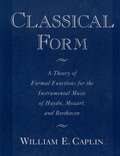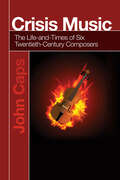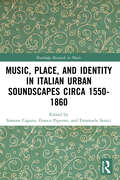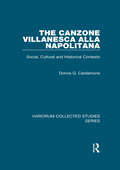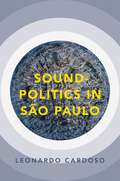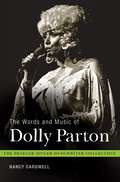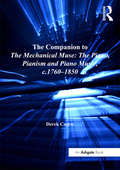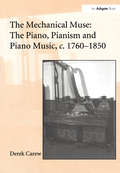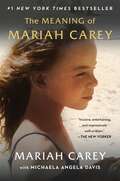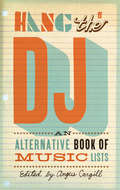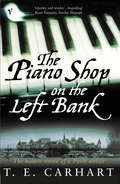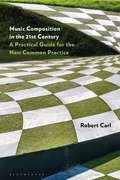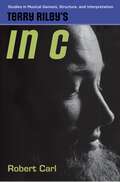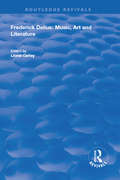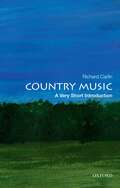- Table View
- List View
Classical Form: A Theory of Formal Functions for the Instrumental Music of Haydn, Mozart, and Beethoven
by William E. CaplinBuilding on ideas first advanced by Arnold Schoenberg and later developed by Erwin Ratz, this book introduces a new theory of form for instrumental music in the classical style. The theory provides a broad set of principles and a comprehensive methodology for the analysis of classical form, from individual ideas, phrases, and themes to the large-scale organization of complete movements. It emphasizes the notion of formal function, that is, the specific role a given formal unit plays in the structural organization of a classical work.
Classical Form: A Theory of Formal Functions for the Instrumental Music of Haydn, Mozart, and Beethoven
by William E. CaplinBuilding on ideas first advanced by Arnold Schoenberg and later developed by Erwin Ratz, this book introduces a new theory of form for instrumental music in the classical style. The theory provides a broad set of principles and a comprehensive methodology for the analysis of classical form, from individual ideas, phrases, and themes to the large-scale organization of complete movements. It emphasizes the notion of formal function, that is, the specific role a given formal unit plays in the structural organization of a classical work.
Crisis Music: The Life-and-Times of Six Twentieth-Century Composers
by John CapsStory-like chapters profile six twentieth-century reactive composers; not the most famous pillars of the period but lesser-known, perhaps more approachable, characters whose stories span that 1900-2000 period from decadent fin-de-siècle Vienna (Alban Berg, Alexander Zemlinsky) to war-torn Paris (Olivier Messiaen, Arthur Honegger) to the Cold War tensions of East vs. West (Tōru Takemitsu) and late-century Communism (Arvo Pärt). Their stories were all very different crises, and they produced very different kinds of music; each very telling of their composers life and times. Crisis Music presents each brief biography almost like a detective story looking for motives, then spotlights one particular piece of music from each composer that emerged directly out of hard times maybe a political crisis at the time of composition (Hitler marching into Paris or later Communist crack-downs); or some personal angst such as illness or scandal and how that music contains and expresses crisis. In short, the subject for discussion is how context influences content. Such troubled and especially vivid composition, crisis music, can often be most compelling and meaningful for its composer and for its time. Indeed, their music also seems to have a special resonance to share with our own crisis-prone times. And meanwhile, Western music history played-out its own story from late-romantic style to Serialism and Minimalism to the anything-goes Pluralism we hear today. Crisis Music sparks the discussion about how history, biography and music intersects. At the behest of music teachers at secondary and tertiary levels, Crisis Music contains substantive Discussion Questions geared for classroom use.
Crisis Music: The Life-and-Times of Six Twentieth-Century Composers
by John CapsStory-like chapters profile six twentieth-century reactive composers; not the most famous pillars of the period but lesser-known, perhaps more approachable, characters whose stories span that 1900-2000 period from decadent fin-de-siècle Vienna (Alban Berg, Alexander Zemlinsky) to war-torn Paris (Olivier Messiaen, Arthur Honegger) to the Cold War tensions of East vs. West (Tōru Takemitsu) and late-century Communism (Arvo Pärt). Their stories were all very different crises, and they produced very different kinds of music; each very telling of their composers life and times. Crisis Music presents each brief biography almost like a detective story looking for motives, then spotlights one particular piece of music from each composer that emerged directly out of hard times maybe a political crisis at the time of composition (Hitler marching into Paris or later Communist crack-downs); or some personal angst such as illness or scandal and how that music contains and expresses crisis. In short, the subject for discussion is how context influences content. Such troubled and especially vivid composition, crisis music, can often be most compelling and meaningful for its composer and for its time. Indeed, their music also seems to have a special resonance to share with our own crisis-prone times. And meanwhile, Western music history played-out its own story from late-romantic style to Serialism and Minimalism to the anything-goes Pluralism we hear today. Crisis Music sparks the discussion about how history, biography and music intersects. At the behest of music teachers at secondary and tertiary levels, Crisis Music contains substantive Discussion Questions geared for classroom use.
Music, Place, and Identity in Italian Urban Soundscapes circa 1550-1860 (Routledge Research in Music)
by Simone Caputo Franco Piperno Emanuele SeniciMusic, Place, and Identity in Italian Urban Soundscapes circa 1550-1860 presents new perspectives on the role music played in the physical, cultural, and civic spaces of Italian cities from the sixteenth to the nineteenth century. Across thirteen chapters, contributors explore the complex connections between sound and space within these urban contexts, demonstrating how music and sound were intimately connected to changing social and political practices. The volume offers a critical redefinition of the core concept of soundscape, considering musical practices through the lenses of territory, space, representation, and identity, in five parts: Soundscape, Phonosphere, and Urban History Urban Soundscapes across Time Urban Soundscapes and Acoustic Communities Urban Soundscapes in Literary Sources Reconstructing Urban Soundscapes in the Digital Era Music, Place, and Identity in Italian Urban Soundscapes circa 1550-1860 reframes our understanding of Italian music history beyond models of patronage, investigating how sounds and musics have contributed to the construction of human identities and communities.
The canzone villanesca alla napolitana: Social, Cultural and Historical Contexts
by Donna G. CardamoneThe printed debut of the canzone villanesca alla napolitana occurred on 24 October 1537, in Naples. Fifteen anonymous 'rustic songs' were published by Johannes de Colonia in a pocket-sized anthology with a cover featuring three women with hoes tilling the soil. The adjective villanesca (from villano or peasant) in the strict sense of the word means rustic or crude, but in this new context it also intimates that Neapolitan poet-musicians had been affected by the instinctive lyrical traditions of everyday people. The articles in this volume trace the Neapolitan origins of this song form, and its subsequent development as it spread quickly throughout Italy in a succession of editions published in Venice and Rome, providing a diverse repertory of lively songs to amuse the privileged that held and attended academies. Several studies focus on key figures in this process, notably Ferrante Sanseverino, Prince of Salerno, and Orlando di Lasso. At the same time the author relates these developments to the contemporary political context, notably the rivalry of Spain and France for control of the Kingdom of Naples.
The canzone villanesca alla napolitana: Social, Cultural and Historical Contexts
by Donna G. CardamoneThe printed debut of the canzone villanesca alla napolitana occurred on 24 October 1537, in Naples. Fifteen anonymous 'rustic songs' were published by Johannes de Colonia in a pocket-sized anthology with a cover featuring three women with hoes tilling the soil. The adjective villanesca (from villano or peasant) in the strict sense of the word means rustic or crude, but in this new context it also intimates that Neapolitan poet-musicians had been affected by the instinctive lyrical traditions of everyday people. The articles in this volume trace the Neapolitan origins of this song form, and its subsequent development as it spread quickly throughout Italy in a succession of editions published in Venice and Rome, providing a diverse repertory of lively songs to amuse the privileged that held and attended academies. Several studies focus on key figures in this process, notably Ferrante Sanseverino, Prince of Salerno, and Orlando di Lasso. At the same time the author relates these developments to the contemporary political context, notably the rivalry of Spain and France for control of the Kingdom of Naples.
Sound-Politics in São Paulo (Currents in Latin American and Iberian Music)
by Leonardo CardosoHow does the state separate music from noise? How can such a filtering apparatus shape the content and form of sound production in the city? As a marker of co-presence to the hearing body, sound is always open to (or rather opens up) the politics of shared existence. In the throes of the post-dictatorship period, Brazil's legislative and executive branches implemented a series of sweeping measures to address quality of life concerns, including environmental pollution and urban inequality. In São Paulo, noise control became a recurrent controversy, growing in size and scale between the 1990s and 2010s. Together with the much-debated fear of crime and the socioeconomic and cultural tensions between the rich urban center and the poor peripheries, such ecological agendas against noise as a harmful pollutant have reconfigured the presence of environmental sounds in the city. In this book, Cardoso argues that the framing of specific sounds as unavoidable, unnecessary, or as harmful "noise" has been an effective strategy to organize spaces and administer group behavior in this rapidly expanding city. He focuses on two interrelated processes. First, the series of institutional regulatory mechanisms that turn sounds into the all-embracing "noise" susceptible to state intervention. Second, the constant attempts of interested groups in either attaching or detaching specific sounds (musical events, industrial noise, traffic noise, religious sounds, etc.) from regulatory scrutiny. Sound-politics is the dynamic that emerges from both processes - the channels through which sounds enter (and leave) the sphere of state regulation.
SOUND-POLITICS IN SAO PAULO CILAM C (Currents in Latin American and Iberian Music)
by Leonardo CardosoHow does the state separate music from noise? How can such a filtering apparatus shape the content and form of sound production in the city? As a marker of co-presence to the hearing body, sound is always open to (or rather opens up) the politics of shared existence. In the throes of the post-dictatorship period, Brazil's legislative and executive branches implemented a series of sweeping measures to address quality of life concerns, including environmental pollution and urban inequality. In São Paulo, noise control became a recurrent controversy, growing in size and scale between the 1990s and 2010s. Together with the much-debated fear of crime and the socioeconomic and cultural tensions between the rich urban center and the poor peripheries, such ecological agendas against noise as a harmful pollutant have reconfigured the presence of environmental sounds in the city. In this book, Cardoso argues that the framing of specific sounds as unavoidable, unnecessary, or as harmful "noise" has been an effective strategy to organize spaces and administer group behavior in this rapidly expanding city. He focuses on two interrelated processes. First, the series of institutional regulatory mechanisms that turn sounds into the all-embracing "noise" susceptible to state intervention. Second, the constant attempts of interested groups in either attaching or detaching specific sounds (musical events, industrial noise, traffic noise, religious sounds, etc.) from regulatory scrutiny. Sound-politics is the dynamic that emerges from both processes - the channels through which sounds enter (and leave) the sphere of state regulation.
The Words and Music of Dolly Parton: Getting to Know Country's "Iron Butterfly" (The Praeger Singer-Songwriter Collection)
by Nancy CardwellThis insightful biography provides a closer look at one of the entertainment world's biggest stars, with a focus on what got her to the top—and what has kept her there.Dolly Parton has an enviable record of accomplishment as a performer, songwriter, recording artist, businesswoman, and philanthropist. She has triumphed on Broadway, in the movies, and even with her own theme park. The Words and Music of Dolly Parton probes its subject's unique singing voice and prolific abilities as a songwriter, as well as her impressive business savvy, fearless attitude, and an imagination as towering as the Smoky Mountains among which she grew up.This book focuses on Parton's most important albums and songwriting style, examining her career from her early days in the east Tennessee mountains through her national television exposure on the Porter Wagoner Show, her crossover success in pop music, and her return to her acoustic/bluegrass roots. In addition, it explores Parton's story songs and characters, the spirituality reflected in her music, and her important collaborations with other artists.
The Companion to The Mechanical Muse: The Piano, Pianism and Piano Music, c.1760–1850
by Derek CarewIntended as a supplement to The Mechanical Muse: The Piano, Pianism and Piano Music, c.1760-1850, this Companion provides additional information which, largely for reasons of space but also of continuity, it was not possible or desirable to include in that volume. The book is laid out alphabetically and full biographical entries are provided for all musical figures mentioned, including composers, performers, theoreticians and teachers, as well as piano makers and publishers of music, within the period covered by The Mechanical Muse. There are also entries on figures of importance from outside the period but whose influence is palpably important within it, such as J.S. Bach. As well as biographical information, all these entries contain lists of principal works and a section on further reading so that readers can follow up people and matters of particular interest. Also included in The Companion are entries devoted to particular works and other information of relevance, such as descriptions of musical forms, characteristics of dances and so on, as well as some technical information on music and explanations of technical terms pertaining to keyboard instruments themselves and to ways of playing them. This Companion is not intended to replace existing reference books such as Grove or Musik in Geschichte und Gegenwart, but will be useful for those who desire to know more about a particular topic and do not necessarily have access to more specialist reference works, or time to visit large or specialist libraries. As such it is indispensable to users of The Mechanical Muse.
The Companion to The Mechanical Muse: The Piano, Pianism and Piano Music, c.1760–1850
by Derek CarewIntended as a supplement to The Mechanical Muse: The Piano, Pianism and Piano Music, c.1760-1850, this Companion provides additional information which, largely for reasons of space but also of continuity, it was not possible or desirable to include in that volume. The book is laid out alphabetically and full biographical entries are provided for all musical figures mentioned, including composers, performers, theoreticians and teachers, as well as piano makers and publishers of music, within the period covered by The Mechanical Muse. There are also entries on figures of importance from outside the period but whose influence is palpably important within it, such as J.S. Bach. As well as biographical information, all these entries contain lists of principal works and a section on further reading so that readers can follow up people and matters of particular interest. Also included in The Companion are entries devoted to particular works and other information of relevance, such as descriptions of musical forms, characteristics of dances and so on, as well as some technical information on music and explanations of technical terms pertaining to keyboard instruments themselves and to ways of playing them. This Companion is not intended to replace existing reference books such as Grove or Musik in Geschichte und Gegenwart, but will be useful for those who desire to know more about a particular topic and do not necessarily have access to more specialist reference works, or time to visit large or specialist libraries. As such it is indispensable to users of The Mechanical Muse.
The Mechanical Muse: The Piano, Pianism and Piano Music, c.1760-1850
by Derek CarewThis book charts the piano's accession from musical curiosity to cultural icon, examining the instrument itself in its various guises as well as the music written for it. Both the piano and piano music were very much the product of the intellectual, cultural and social environments of the period and both were subject to many influences, directly and indirectly. These included character (individualism), the vernacular ('folk/popular') and creativity (improvisation), all of which are discussed generally and with respect to the music itself. Derek Carew surveys the most important pianistic genres of the period (variations, rondos, and so on), showing how these changed from their received forms into vehicles of Romantic expressiveness. The piano is also looked at in its role as an accompanying instrument. The Mechanical Muse will be of interest to anyone who loves the piano or the period, from the non-specialist to the music postgraduate.
The Mechanical Muse: The Piano, Pianism and Piano Music, c.1760-1850
by Derek CarewThis book charts the piano's accession from musical curiosity to cultural icon, examining the instrument itself in its various guises as well as the music written for it. Both the piano and piano music were very much the product of the intellectual, cultural and social environments of the period and both were subject to many influences, directly and indirectly. These included character (individualism), the vernacular ('folk/popular') and creativity (improvisation), all of which are discussed generally and with respect to the music itself. Derek Carew surveys the most important pianistic genres of the period (variations, rondos, and so on), showing how these changed from their received forms into vehicles of Romantic expressiveness. The piano is also looked at in its role as an accompanying instrument. The Mechanical Muse will be of interest to anyone who loves the piano or the period, from the non-specialist to the music postgraduate.
The Meaning of Mariah Carey
by Mariah CareyThe global icon, award-winning singer, songwriter, producer, actress, mother, daughter, sister, storyteller, and artist finally tells the unfiltered story of her life in The Meaning of Mariah Carey.It took me a lifetime to have the courage and the clarity to write my memoir. I want to tell the story of the moments - the ups and downs, the triumphs and traumas, the debacles and the dreams, that contributed to the person I am today. Though there have been countless stories about me throughout my career and very public personal life, it’s been impossible to communicate the complexities and depths of my experience in any single magazine article or a ten-minute television interview. And even then, my words were filtered through someone else’s lens, largely satisfying someone else’s assignment to define me.This book is composed of my memories, my mishaps, my struggles, my survival and my songs. Unfiltered. I went deep into my childhood and gave the scared little girl inside of me a big voice. I let the abandoned and ambitious adolescent have her say, and the betrayed and triumphant woman I became tell her side.Writing this memoir was incredibly hard, humbling and healing. My sincere hope is that you are moved to a new understanding, not only about me, but also about the resilience of the human spirit.Love,Mariah
Hang the DJ: An alternative book of music lists
by Angus Cargill'Entertaining and addictive' (Metro) Hang the DJ is the must-read book of music lists, for all true music fans. In the hearts of all music lovers there are lists - from the best break-up songs, to the best drinking songs; the perfect mix-tape to the dream set-list; Dylan's dirtiest songs, to Tom Waits' saddest. Hang the DJ compiles the sort of thing you might once have scribbled in the back of your school book: musical loves and hates, dreams and nightmares. With contributions from novelists (Ali Smith, David Peace, Jonathan Lethem, Michel Faber), musicians (Kathryn Williams, Willy Vlautin, Jeb Loy Nichols, Tom McRae) and music writers (Nick Kent, Laura Barton, Simon Reynolds, Jon Savage) this is a collection that will inspire and provoke and send you back to your music collection, to old favourites and guilty pleasures alike.
The Piano Shop On The Left Bank: Discovering A Forgotten Passion In A Paris Atelier
by T E CarhartT. E. Carhart, an American living in Paris, is intrigued by a piano repair shop hidden down a street near his apartment. When he finally gains admittance to the secretive world of the atelier, he finds himself in an enormous glass-roofed workshop filled with dozens of pianos. His love affair with this most magical of instruments and its music is reawakened. Packed with delicate cameos of Parisians and reflections on how pianos work and their glorious history, The Piano Shop on the Left Bank is an atmospheric and absorbing journey to an older way of life.
Music Composition in the 21st Century: A Practical Guide for the New Common Practice
by Robert CarlThe state of contemporary music is dizzyingly diverse in terms of style, media, traditions, and techniques. How have trends in music developed over the past decades? Music Composition in the 21st Century is a guide for composers and students that helps them navigate the often daunting complexity and abundance of resources and influences that confront them as they work to achieve a personal expression.From pop to classical, the book speaks to the creative ways that new composers mix and synthesize music, creating a music that exists along a more continuous spectrum rather than in a series of siloed practices. It pays special attention to a series of critical issues that have surfaced in recent years, including harmony, the influence of minimalism, the impact of technology, strategies of "openness," sound art, collaboration, and improvisation. Robert Carl identifies an emerging common practice that allows creators to make more informed aesthetic and technical decisions and also fosters an inherently positive approach to new methods.
Music Composition in the 21st Century: A Practical Guide for the New Common Practice
by Robert CarlThe state of contemporary music is dizzyingly diverse in terms of style, media, traditions, and techniques. How have trends in music developed over the past decades? Music Composition in the 21st Century is a guide for composers and students that helps them navigate the often daunting complexity and abundance of resources and influences that confront them as they work to achieve a personal expression.From pop to classical, the book speaks to the creative ways that new composers mix and synthesize music, creating a music that exists along a more continuous spectrum rather than in a series of siloed practices. It pays special attention to a series of critical issues that have surfaced in recent years, including harmony, the influence of minimalism, the impact of technology, strategies of "openness," sound art, collaboration, and improvisation. Robert Carl identifies an emerging common practice that allows creators to make more informed aesthetic and technical decisions and also fosters an inherently positive approach to new methods.
Terry Riley's In C (Studies in Musical Genesis, Structure, and Interpretation)
by Robert CarlSetting the stage for a most intriguing journey into the world of minimalism, Robert Carl's Terry Riley's In C argues that the work holds its place in the canon because of the very challenges it presents to "classical" music. Carl examines In C in the context of its era, its grounding in aesthetic practices and assumptions, its process of composition, presentation, recording, and dissemination.
Terry Riley's In C (Studies in Musical Genesis, Structure, and Interpretation)
by Robert CarlSetting the stage for a most intriguing journey into the world of minimalism, Robert Carl's Terry Riley's In C argues that the work holds its place in the canon because of the very challenges it presents to "classical" music. Carl examines In C in the context of its era, its grounding in aesthetic practices and assumptions, its process of composition, presentation, recording, and dissemination.
Frederick Delius: Music, Art and Literature (Routledge Revivals)
by Lionel CarleyFirst published in 1998, Carley collates twelve essays by an international group of contributors reflects the truly cosmopolitan nature of Delius’s life and his music. They reveal the manner in which he absorbed the culture of the nations he came to know, their music, art and literature, and the influences they brought to bare on his own work. Also discussed are some of the often mixed, but rarely equivocal reactions that performances of his music have reactions over the years, with Lionel Carley’s in-depth study of the first production of Foleraadet in 1897, and a wide ranging analysis by Don Gillespie and Robert Beckhard of the critical reception of Delius’s music in the United States between 1909 and 1920.
Frederick Delius: Music, Art and Literature (Routledge Revivals)
by Lionel CarleyFirst published in 1998, Carley collates twelve essays by an international group of contributors reflects the truly cosmopolitan nature of Delius’s life and his music. They reveal the manner in which he absorbed the culture of the nations he came to know, their music, art and literature, and the influences they brought to bare on his own work. Also discussed are some of the often mixed, but rarely equivocal reactions that performances of his music have reactions over the years, with Lionel Carley’s in-depth study of the first production of Foleraadet in 1897, and a wide ranging analysis by Don Gillespie and Robert Beckhard of the critical reception of Delius’s music in the United States between 1909 and 1920.
Country Music: A Biographical Dictionary (Very Short Introductions)
by Richard CarlinCountry Music: A Very Short Introduction presents a compelling overview of the music and its impact on American culture. Country music has long been a marker of American identity; from our popular culture to our politics, it has provided a soundtrack to our national life. While traditionally associated with the working class, country's appeal is far broader than any other popular music style. While this music rose from the people, it is also a product of the popular music industry, and the way the music has been marketed to its audience is a key part of its story. Key artists, songs, and musical styles are highlighted that are either touchstones for a particular social event (such as Tammy Wynette's "Stand By Your Man," which produced both a positive and negative backlash as a marker of women's roles in society at the beginning of the liberation movement) or that encompass broader trends in the industry (for example, Jimmie Rodgers' "T for Texas" was an early example of the appropriation of black musical forms by white artists to market them to a mainstream audience). While pursuing a basically chronological outline, the book is structured around certain recurring themes (such as rural vs. urban; tradition vs. innovation; male vs. female; white vs. black) that have been documented through the work of country artists from the minstrel era to today. Truly the voice of the people, country music expresses both deep patriotism as well as a healthy skepticism towards the powers that dominate American society. Country Music: A Very Short Introduction illuminates this rich tradition and assesses its legacy in American popular music culture.
Country Music: A Very Short Introduction (Very Short Introductions)
by Richard CarlinCountry Music: A Very Short Introduction presents a compelling overview of the music and its impact on American culture. Country music has long been a marker of American identity; from our popular culture to our politics, it has provided a soundtrack to our national life. While traditionally associated with the working class, country's appeal is far broader than any other popular music style. While this music rose from the people, it is also a product of the popular music industry, and the way the music has been marketed to its audience is a key part of its story. Key artists, songs, and musical styles are highlighted that are either touchstones for a particular social event (such as Tammy Wynette's "Stand By Your Man," which produced both a positive and negative backlash as a marker of women's roles in society at the beginning of the liberation movement) or that encompass broader trends in the industry (for example, Jimmie Rodgers' "T for Texas" was an early example of the appropriation of black musical forms by white artists to market them to a mainstream audience). While pursuing a basically chronological outline, the book is structured around certain recurring themes (such as rural vs. urban; tradition vs. innovation; male vs. female; white vs. black) that have been documented through the work of country artists from the minstrel era to today. Truly the voice of the people, country music expresses both deep patriotism as well as a healthy skepticism towards the powers that dominate American society. Country Music: A Very Short Introduction illuminates this rich tradition and assesses its legacy in American popular music culture.
